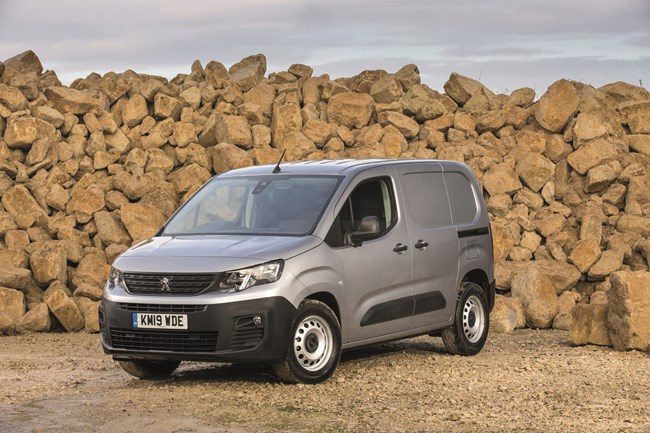- Toyota Hilux range gains new rally-inspired GR Sport II variant
- Remarketing: Pick of the bunch
- GA Commercial acquires first vans through Vanaways
- 'Luxury' tax on expensive pick-up trucks suggested
- ADVERTISEMENT FEATURE: Essential advice to avoid the van fleet ICE-berg
- ETRUX launches new Ford E-Transit Trizone
- Renault gives UK debut to Master E-Tech at CV Show
- Isuzu D-Max long-term test – Latest Report
- Isuzu D-Max V-Cross Steel Edition revealed
- IVOTY Report: Stellantis explores the hydrogen proposition
Buying a used... Peugeot Partner (2018)
Date: Wednesday, February 15, 2023 | Author: Ian Shaw
In the 1990s the Peugeot Partner was credited with spearheading the French revolution.

The Partner and its Citroën sibling, the Berlingo were thought of as revolutionaries in the LCV world upon arrival in 1996. However, in design terms, they merely rounded-off the corners of the established car-cube designs from the Fiat Fiorino or Renault’s 5-based Extra van. In doing so they forced their forebears to follow and the Kangoo and Doblo joined forces with them to create the European domination of the class. Fast-forward to the third generation in 2018, however, and you see a different animal. The Partner had moved up a full class, effectively into the original Expert’s shoes and left any car-derived ancestry behind. Now, that was revolutionary. Thereafter its family grew, The Sevel dynasty of Peugeot-Citroën and Fiat being joined by GM’s European family of Vauxhall/Opel to create Stellantis. The strength of the Sevel core shone through, with a mere badging exercise to satisfy Vauxhall and Toyota’s aspirations in the class.
One thing that has carried right through from 1996 is the excellent HDi diesel engine range. It has shrunk in capacity from its original 2.0-litre, down through 1.6 and eventually to 1.5-litres, following its direction in passenger car applications. The van state-of-tune was always more about torque and flexibility and despite the drop in cylinder capacity, advancing electronics have kept the driveability, albeit with an increasingly ‘woolly’ feel. The 1.6-litre version musters 75hp and 230Nm of torque or 100hp and 250Nm, rising to 130hp and some 300Nm in the early Euro-6 1.5 litre unit. After mid-2019 the range was unified at 1.5- litres but produced exactly the same outputs with the torque still peaking at a commendably low 1,750rpm. The only way to get more torque at less revs, is the direction we all now take; the electric motor. Either 1.5 or 1.6-litre versions drive well, the 1.5 seems a little quieter but it’s probably more to do with installation. The short-lived 1.2-litre petrol was always an LCV Cul de Sac to pander to the diesel-doomers and a potential CNG rebirth needing spark-ignition. Transmissions are the super-slick six-speed manual or an eight-speed automatic. Combined with the high output 1.5 HDi, it’s a gem. The driving position is good, visibility decent, ride comfort great and equipment levels generous, on upper models.
In the back, it’s good news too. A 1,000kg payload at most with load volumes from 3.3m3 for standard version cab through to 4.4m3 for the Partner-Long with load-through cab. Within the van, load lengths of 1.8 and 2.1m can be accommodated, a height of 1.2 and width between arches of 1.5m complete the picture. Roof flap and Extenso cab options offer scope for long loads beyond that. Depending upon the model, up to 1,200kg can be towed too.
The main issue with the partner is the i-Cockpit. Peugeot’s small steering wheel, pseudo-head-up instruments and screen-based functions are meant to be more sporty, but the otherwise identical Berlingo has a conventional facia with larger steering wheel and is all the better for it.
Five best options
1) 1.5HDi 130
2) Automatic transmission
3) Premium trim
4) Asphalt trim
5) Extenso cab
Five best avoided
1) 1.6HDi 75
2) Petrol engine
3) Basic trims
4) Crew van
5) Long version
Second-hand buys
|
Version |
Plate |
Year |
Mileage |
Price exVAT |
|
1.6HDi Professional |
68 |
2018 |
93,000 |
£12,495 |
|
1.6HDi Professional |
19 |
2019 |
125,000 |
£15,995 |
|
1.5HDi Professional |
69 |
2020 |
57,000 |
£16,995 |
|
1.5HDi Professional Premium |
71 |
2021 |
10,000 |
£20,995 |
|
1.5HDi Professional Premium |
72 |
2022 |
3,000 |
£22,495 |
View The WhatVan Digital Edition


